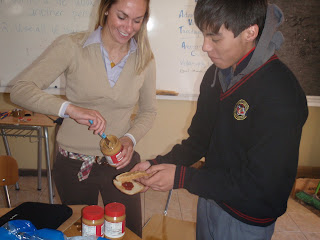 My American Cultures extracurricular class rocked peanut butter and jelly today! Be proud, fellow Americans – I represented our great land quite well with our childhood’s favorite staple. One advantage of Chile – I didn’t need a permit for peanut butter in a public school. Peanut allergies must go undiagnosed or do not exist here.
My American Cultures extracurricular class rocked peanut butter and jelly today! Be proud, fellow Americans – I represented our great land quite well with our childhood’s favorite staple. One advantage of Chile – I didn’t need a permit for peanut butter in a public school. Peanut allergies must go undiagnosed or do not exist here.Safeway peanut butter, marmelada de frutilla (strawberry jelly), and Lider brand sliced white pan combined to create an entirely new flavor sensation for my students. As we smeared the spreads we also jammed out to the Brendan Borek Family 3 tunes (which most of you have in your music collections from the Shoobie Roundup).
You might ask – Cat, where’s the lesson plan? No need to fret – the food historian in me researched the genesis of peanut butter and jelly. Apparently, jams and preserves date well into our civilized history. Peanut butter emerged in the late 1800s (crushed almonds pre-date the smashed peanuts) as a ritzy luxury served to the Vanity Fair crowd. Without sugar, it matched more savory items in tea sandwiches. The 1920s proved to be not only a turning point for women’s rights and prohibition, but also for our beloved sandwiches. Sliced bread appeared on grocery store shelves and suddenly life became a bit easier.
While the process of making peanut butter improved, the hearty accompaniment only made appearances at high teas and upscale functions. World War II changed everything. Slight understatement – let’s not forget WWII also brought Jello and recycling to the forefront (please reference my senior thesis on the salvage efforts of WWII). The GIs needed a non-perishable meal for the battle field. The US government provided rations of peanut butter and jelly. Add some sliced bread and voila! When the soldiers returned from war, they craved their protein-rich, convenient snack. Manufacturers caught wind of the popularity and created a more economical process that also added sugar to the ingredients, which attracted an entirely new audience: children. Fast forward 60 years, many successful folks continue to eat PB&J well into adulthood. Example: John Kerry has a peanut butter sandwich before speaking engagements to hold off hunger (as I witnessed at the Franklin Institute).
Ok, you might still say: But, Cat, you’re teaching English…not food history. Did I mention this is an advanced class? In conversation, we came across the following new words/phrases: delicacy, tasty, delicious, soooo good, manufacturer, nutritious, spooky, rations, upscale, fluff, perishable, sorry, that went down the wrong pipe, etc. We also watched a youtube clip of a woman explaining how to make a peanut butter and jelly sandwich to test listening comprehension. Yes, these videos exist. Subsequently, we spent a few minutes laughing and questioning why anyone would have enough time in their life to record a video about such a simple task.
By the end of the two hours, I was quite happy to sit back and watch my students laughing, joking in English, dancing to my music, and enjoying a bit of American culture.
Hope you enjoy the photos linked here - a few views from my window, the exterior of my school, my classroom and a video of my students, and my American Cultures Class (classroom shots taken today, October 8th). Now I must shower because I walked to my tutoring gig this afternoon along a dirty road for 45 minutes...I'm quite grimy! http://picasaweb.google.com/mcatherinelambert/SchoolAndPBJ#
upDATE: In the collectivo on the way home from the tutoring gig, a very nice man and I had a little Spanish convo (I was very proud/surprised regarding my sentences). At the end of the convo, in perfectly clear English, he asked: phone number? I took the lesson from class today to heart...and lied: I don't have a phone.
1 comment:
hahahaha "I don't have a phone"
I used that one a coupla times...esp in Colectivos, praying that the thing wouldn't start ringing en route :)
Post a Comment